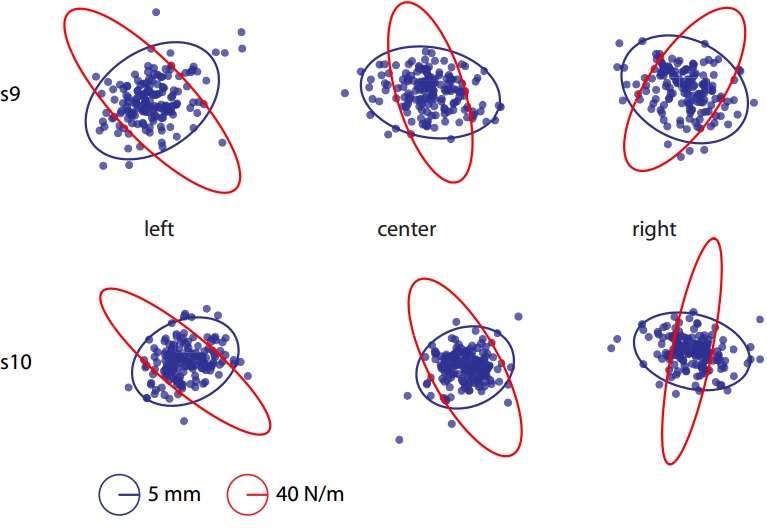These studies focus on the
relationship between the mechanical behavior of the limb,
or the jaw in the case of speech, and patterns of limb
movement and learning.
Laboissiere R, Lametti DR, Ostry DJ (2009) Impedance
control and its relation to precision in orofacial
movement. J Neurophysiol 102:523-531.
Abstract PDF
Speech production involves some of the most
precise and finely timed patterns of human movement.
Here, in the context of jaw movement in speech, we
show that spatial precision in speech production is
systematically associated with the regulation of
impedance and in particular, with jaw stiffness—a
measure of resistance to displacement. We estimated
stiffness and also variability during movement using a
robotic device to apply brief force pulses to the jaw.
Estimates of stiffness were obtained using the
perturbed position and force trajectory and an
estimate of what the trajectory would be in the
absence of load. We estimated this “reference
trajectory” using a new technique based on Fourier
analysis. A moving-average (MA) procedure was used to
estimate stiffness by modeling restoring force as the
moving average of previous jaw displacements. The
stiffness matrix was obtained from the steady state of
the MA model. We applied this technique to data from
31 subjects whose jaw movements were perturbed during
speech utterances and kinematically matched nonspeech
movements. We observed systematic differences in
stiffness over the course of jaw-lowering and
jaw-raising movements that were correlated with
measures of kinematic variability. Jaw stiffness was
high and variability was low early and late in the
movement when the jaw was elevated. Stiffness was low
and variability was high in the middle of movement
when the jaw was lowered. Similar patterns were
observed for speech and nonspeech conditions. The
systematic relationship between stiffness and
variability points to the idea that stiffness
regulation is integral to the control of orofacial
movement variability.
Darainy M, Mattar AAG, Ostry DJ DJ (2009) Effects
of human arm impedance on dynamics learning and
generalization. J Neurophysiol 101:3158–3168.
Abstract PDF
Previous studies have demonstrated anisotropic
patterns of hand impedance under static conditions and
during movement. Here we show that the pattern of
kinematic error observed in studies of dynamics
learning is associated with this anisotropic impedance
pattern. We also show that the magnitude of kinematic
error associated with this anisotropy dictates the
amount of motor learning and, consequently, the extent
to which dynamics learning generalizes. Subjects were
trained to reach to visual targets while holding a
robotic device that applied forces during movement. On
infrequent trials, the load was removed and the
resulting kinematic error was measured. We found a
strong correlation between the pattern of kinematic
error and the anisotropic pattern of hand stiffness.
In a second experiment subjects were trained under
force-field conditions to move in two directions: one
in which the dynamic perturbation was in the direction
of maximum arm impedance and the associated kinematic
error was low and another in which the perturbation
was in the direction of low impedance where kinematic
error was high. Generalization of learning was
assessed in a reference direction that lay
intermediate to the two training directions. We found
that transfer of learning was greater when training
occurred in the direction associated with the larger
kinematic error. This suggests that the anisotropic
patterns of impedance and kinematic error determine
the magnitude of dynamics learning and the extent to
which it generalizes.
Lametti DR, Houle G, Ostry DJ (2007) Control of
movement variability and the regulation of limb
impedance. J Neurophysiol 98:3516-3524.
Abstract PDF
Humans routinely make movements to targets that
have different accuracy requirements in different
directions. Examples extend from everyday occurrences
such as grasping the handle of a coffee cup to the
more refined instance of a surgeon positioning a
scalpel. The attainment of accuracy in situations such
as these might be related to the nervous system's
capacity to regulate the limb's resistance to
displacement, or impedance. To test this idea,
subjects made movements from random starting locations
to targets that had shape-dependent accuracy
requirements. We used a robotic device to assess both
limb impedance and patterns of movement variability
just as the subject reached the target. We show that
impedance increases in directions where required
accuracy is high. Independent of target shape,
patterns of limb stiffness are
seen to predict spatial patterns of movement
variability. The nervous system is thus seen to
modulate limb impedance in entirely predictable
environments to aid in the attainment of reaching
accuracy.
Darainy M, Malfait N, Gribble PL, Towhidkhah F, Ostry
DJ (2004) Learning to control arm stiffness under static
conditions. J Neurophysiol
92:3344-3350.
Abstract PDF
We used a robotic device to test the
idea that impedance control involves a process of
learning or adaptation that is acquired over time
and permits the voluntary control of the pattern of
stiffness at the hand. The tests were conducted in
statics. Subjects were trained over the course of
three successive days to resist the effects of one
of three different kinds of mechanical loads, single
axis loads acting in the lateral direction, single
axis loads acting in the forward/backward direction
and isotropic loads that perturbed the limb in eight
directions about a circle. We found that subjects in
contact with single axis loads voluntarily modified
their hand stiffness orientation such that changes
to the direction of maximum stiffness mirrored the
direction of applied load. In the case of isotropic
loads, a uniform increase in endpoint stiffness was
observed. Using a physiologically realistic model of
two-joint arm movement, the experimentally
determined pattern of impedance change could be
replicated by assuming that coactivation of elbow
and double joint muscles was independent of
coactivation of muscles at the shoulder. Moreover,
using this pattern of coactivation control we were
able to replicate an asymmetric pattern of rotation
of the stiffness ellipse that was observed
empirically. The present findings are consistent
with the idea that arm stiffness is controlled
through the use of at least two independent
cocontraction commands.
